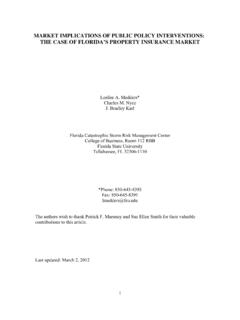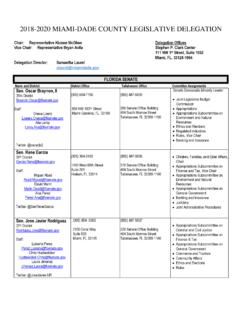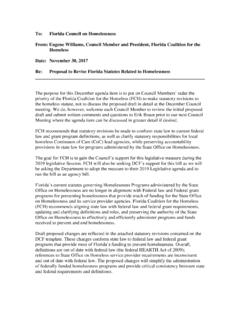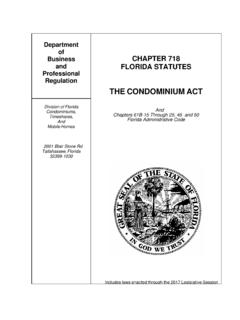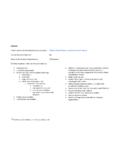Transcription of The State of Florida’s - Florida Catastrophic Storm Risk ...
1 The State of Florida s Property Insurance Market 2nd Annual Report Released January 2013 for the Florida Legislature by The Florida Catastrophic Storm Risk Management Center 1 Table of Contents Executive Summary .. 3 Introduction .. 8 Framework .. 8 Stakeholders .. 8 Current Marketplace Challenges .. 8 Property Insurance Market History .. 9 Legislative and Regulatory Activity .. 10 State Involvement in Property Insurance .. 13 Citizens Property Insurance Corporation .. 13 The Florida Hurricane Catastrophe Fund .. 14 Florida Insurance Guaranty Association .. 15 Primary Market Structure .. 15 Benefits of Private Market .. 18 Pricing of Risk .. 18 Incentives to Mitigate .. 18 Diversification beyond Florida .. 19 Exposure .. 19 Exposure Trends .. 20 Pricing .. 23 Rate Level Trends .. 23 Role of Catastrophe 24 Reinsurance Pricing .. 25 Regulatory Environment Factors .. 26 Impact of Mandatory Mitigation Credits.
2 26 Non-windstorm Losses: Sinkholes .. 29 Non-windstorm Losses: Lengthening of the Property Claims Tail .. 31 Private Market Performance .. 32 32 Private Insurance Availability .. 34 Number of Companies and Their Structure .. 35 Premiums and Surplus .. 36 Profitability .. 38 Market Size and Capitalization .. 39 Market Concentration .. 41 Leverage .. 42 Reinsurance Market Current Structure .. 46 Benefits of Reinsurance to the Florida Marketplace .. 46 Pricing of Risk .. 47 Access to Capital Markets .. 47 The Citizens 2012 Catastrophe Bond Issue .. 48 Measuring the Net Effects .. 48 Insurance Market Impact: Changing Exposure Levels .. 48 State Aggregate Exposure .. 49 2 Private Market 49 FHCF Exposure .. 50 Consumer Impact: True Cost to Florida Consumers .. 50 Assessment Structures and Processes .. 51 Subsidies in the Assessments .. 62 Economic Impact: Where do we go from here? .. 62 Conclusions.
3 63 Appendix A Data Sources & Data Limitations .. 64 Quarterly Supplemental Reports .. 64 NAIC Database of Insurer Annual Reports .. 64 Appendix B Company 65 Appendix C -- Citizens Policies and Occupied Housing Units by Legislative 78 Appendix D References .. 84 3 Executive Summary The number and magnitude of Catastrophic events in recent years, such as the September 11, 2001 terrorist attacks, Hurricane Katrina, and the March, 2011 Japanese tsunami, have inspired a rise in the attention devoted to catastrophes. The impact of catastrophes on insurance markets, in particular, has been a subject of attention from policymakers, the media, academics and the general public in recent years. Beginning with Hurricane Andrew in 1992, Florida has been at the forefront of discussions related to natural catastrophes and insurance markets. The State , given its loss history and exposure to hurricanes, provides an excellent setting to analyze the effect that catastrophe exposure and catastrophe losses have on property insurance market operations and performance.
4 This report serves as an update to The State of Florida s Property Insurance Market 2011 report completed by the Florida Catastrophic Storm Risk Management Center in December, 2011. First, the report provides a brief history of events, legislative and regulatory activity, and the State of Florida s involvement in residential property insurance. Second, a thorough analysis of the primary property insurance market in Florida is provided, including information on exposure, pricing, and regulatory factors that have significant effects on insurer performance. Third, the report discusses the data regarding competition, insurance availability, supply-side size and market structure, as well as financial performance of Florida insurers, and provides a comparison to other hazard prone states . Fourth, the reinsurance and other capital markets available to Florida are reviewed. Fifth, the report evaluates the impact of all of these factors by examining the State s exposure levels and the effect on consumers of the potential post-loss assessments.
5 Finally, the report poses some open questions regarding the economic impact of the market structure that is currently in place in the State . The most prominent challenge facing Florida is the current and future exposure to Catastrophic windstorms. The current condition of the Florida property insurance market has developed from a confluence of natural and man-made events that have taken place over the last three decades. Hurricane Andrew in 1992 and the combined effects of the 2004/2005 Storm seasons, population growth and changing demographics, the evolution of the catastrophe modeling industry, management of catastrophe exposure by insurers/reinsurers, and legislative/regulatory actions in Florida have all contributed to the current market conditions. The lack of significant incentives to mitigate, the dependence on coastal development as an economic driver and the potential impact of climate change on Storm activity and damages are all challenges facing the marketplace.
6 The Historical Context In 1995, as one of several responses to the devastating effect of Andrew on the State of Florida , Florida State Budget Specific Appropriation 1743A created the Academic Task Force on Hurricane Disaster Insurance to review Florida s market system for Storm disaster insurance. The Task Force final report, Restoring Florida s Paradise, (popularly known as the Collins Report) 4proposed a Balanced Equation approach with the goal to reestablish a healthy, competitive private insurance market within two to five years. Characteristics of a healthy, competitive private insurance market mentioned in the Collins Report: 1. Coverage by financially strong private companies of most of Florida s homeowners for hurricane risk; 2. Affordable, competitive rates consistent with widespread coverage of homeowners by private companies; 3. Low numbers of the truly uninsurable in one remaining public insurance entity; 4.
7 A strong Florida Hurricane Catastrophe Fund; and 5. A limit on market share for any one company in high-risk areas. The proposed plan called on private homeowners insurance companies to continue to pay for most hurricane catastrophe damages. It further recommended cooperation and mutual responsibility among private insurers, individual homeowners, banking industry, private capital markets, and local, State and Federal governments for the health of the private insurance system. The Collins Report outlined major components of its Balanced Equation in an effort to establish the abovementioned healthy, competitive private market characteristics. (The full report is available at ) Since the time of the Collins Report, Florida has seen major changes in its property insurance market system, most of which have not resulted in a healthier insurance market. The State , however, has made strides during this time toward reducing the underlying risk, both through improvements in knowledge of the risk and through strengthened building codes.
8 Internal risk reduction through improvement in knowledge of the risk. Florida leads the other 49 states in the use of catastrophe models to estimate the risk, and created the Florida Commission on Hurricane Loss Projection Methodology ( Commission ) to evaluate the accuracy and reliability of the modeling process used to set base insurance rates for the homeowners market. Florida requires residential property insurers to use loss costs from a catastrophe model approved by the Commission for residential insurance pricing. The Commission collaborates with modelers to continue improvement of risk knowledge. External risk reduction through strengthened building codes. Early 2012, the Insurance Institute for Business and Home Safety (IBHS) released a report rating building codes in 18 hurricane-prone states located along the Gulf of Mexico and the Atlantic Coast based on an IBHS-directed study.
9 The study measured the building regulatory systems that hurricane-prone states have in place to promote life safety and property protection. Florida rated highest out of the 18 states with an overall score of 95 out of 100. 5 Unfortunately, risk reduction on existing construction has not met with the same success as with new construction due to problems within the My Safe Florida Home (MSFH) and Insurance Mitigation Discounts programs (discussed in detail in The State of Florida s Property Insurance Market 2011 available at ). And also unfortunate, Florida must be given low marks for the achievement of a healthy, competitive private residential insurance market. This report focuses primarily on the health status and continuing challenges of the insurance marketplace. Marketplace Challenges The most prominent challenge to the Florida residential insurance market is the State s current and future exposure to Catastrophic windstorms.
10 Catastrophe exposure has in fact driven the evolution of Florida s property insurance market. The series of actions and reactions that have followed Hurricane Andrew in 1992 all stem from attempting to address this basic underlying driver. Attempts at effective public policy are made more challenging by: 1) The lack of homeowner-perceived incentives to mitigate; 2) Reliance on coastal development as an economic driver; 3) The potential impact of climate change on Storm activity; and 4) Affordability of property insurance premiums. But effective public policy must be accomplished for a return to Florida as a State where citizens and taxpayers have confidence in its disaster insurance market to be possible. Florida s property insurance market, simply put, does not meet the Collins Report healthy market standard on any front. Lack of coverage by financially strong private companies. A shift in private insurance market domination from large, geographically diverse companies to small domestic insurers has taken place since the time of the Collins Report and private market capacity and performance have declined.
